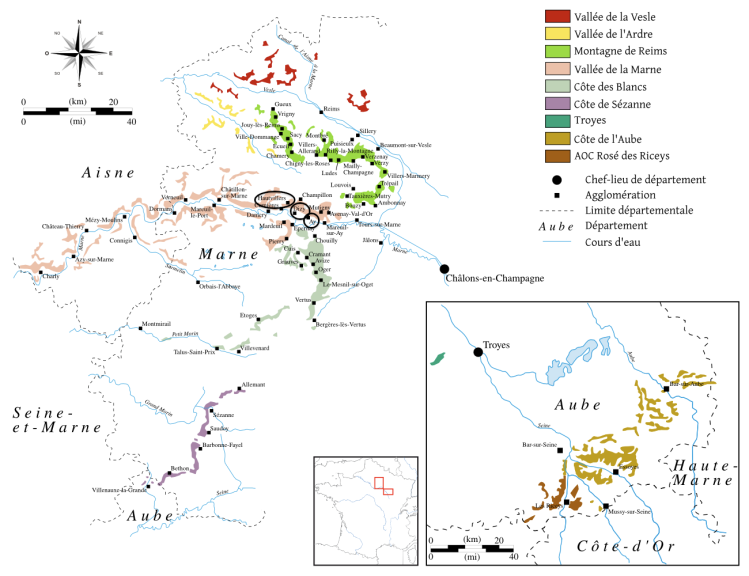Wine Tasted
- Gaston Chiquet, Cuveé Tradition, Brut – Premier Cru, Champagne, Non Vintage
In preparing for a recent Champagne tasting with friends, I undertook some background reading and came across a piece by Tom Stevenson in The Southeby’s Wine Encyclopedia about who invented Champagne.
Being familiar with the delightful story of how Dom Pérignon discovered “stars” in a bottle of wine and thus Champagne was born, I had assumed it had all begun in France.
Quite the contrary it would appear given the popularity Champagne enjoyed in England during the late 17th Century, as evidenced by dramatist Sir George Etherege in his play The Man of Mode, where he wrote about “sparkling Champaign” in 1676. This is a number of years before Dom Pérignon’s discovery in Champagne in the 1690’s. [1]
In addition to documented accounts of sparkling wine in English literature, the technology of bottle production during this time further supports the notion that the English invented sparkling wine. Glass production in France was then wood-fired which produced a bottle unable to withstand the pressure of a sparkling wine. The English on the other hand produced a more robust glass bottle that was coal-fired, thus allowing them to preserve the sparkle in the wine.
The wine I presented for tasting was from Gaston Chiquet, a small grower-producer with vineyards in Aÿ, Hautvillers and Dizy within the Valleé de la Marne region of Champagne.

With vines dating as far back as 1746 the Chiquet family have a rich history of grape growing and champagne production. On a side note, there is also a familial connection with another of my favourite producers, Jacquesson – current winemakers Antoine and Nicolas Chiquet are cousins of Jacquesson negotiants Jean-Hervé and Laurent Chiquet.
Gaston Chiquet include the disgorgement date (June 2012) on the back of the bottle for the Non Vintage Champagne we tasted. (For a brief overview of the Champagne production process see my earlier article on Salon Champagne.) Together with the helpful notes provided on the website we know the base wine was blended from different parcels of the 2009 vintage, an excellent vintage in Champagne which saw good levels of concentration and acidity.
Pale lemon in colour this Champagne presented a delicious nose of lemon curd, burnt butter, brioche and honey with a hint of white floral freshness. Visibly fine bubbles, or bead, and a creamy mousse in the mouth leading to flavours of golden delicious apples, ruby red grapefruit, dark rich Manuka honey, almonds and a flavour that reminded me Champagne sits on top a bed of chalk stretching west underneath Paris and eventually presenting itself as the White Cliffs of Dover in England. I enjoyed the complexity on the palate this Champagne offered and must confess to enjoying the rest of the bottle that evening, after the tasting had finished!
Having been described as the Cliff Clavin of random wine facts it is no surprise I am fascinated to read that of the 15,000 growers in Champagne as at 2011 only 3,750 actually make Champagne themselves, the remainder selling their grapes to others for production. And, in a bid to vindicate my terror at opening any bottle of sparkling wine, did you know that the pressure inside a bottle of Champagne is equivalent to that of a double decker bus tire? [2]
With six twists of any Champagne cage to open it (try it, it’s true) and 250 million bubbles in a bottle of Champagne, what more is there to love about this truly special wine that should be enjoyed not just on those rare occasions but for whenever the mood takes you?
Happy Drinking!
Related Happy Wine Woman Posts
Perrier-Jouët, Belle Époque, 2006
48 hours in Épernay – Perrier-Jouët
48 hours in Épernay – Champagne AR Lenoble
48 hours in Épernay – Besserat de Bellefon
Tasting Note
Gaston Chiquet, Cuveé Tradition, Brut – Premier Cru, Champagne, Non Vintage. Pinot Meunier (45%), 35% Chardonnay (35%), Pinot Noir (20%).
Clear, medium minus lemon colour. Fine bead with a creamy mousse in the mouth. Aromas of lemon curd, honey, burnt butter, brioche and the freshness of white flowers. On the palate golden delicious apples (baked), honey, grapefruit (ruby), almonds and a minerality suggesting chalk. Very good balance of fruit and acidity showing a nice complexity on the palate of both primary and some secondary characteristics with a medium finish.
Where can you get this wine?
Reading
Johnson, H. & Robinson, J. (2007). The World Atlas of Wine. Great Britain: Mitchell Beazley.
Robinson, J. (2006). The Oxford Companion to Wine. Great Britain: Oxford University Press.
Stevenson, T. (2011). The Sotheby’s Wine Encyclopedia. New York: DK Publishing.


Another really good article ‘Cliff’. Not a grower I have come across but will keep an eye out for. Tasting note is intriguing, lots going on their which always makes for an interesting wine experience. Keep up the dedicated study 🙂
Will do-thanks! 🙂